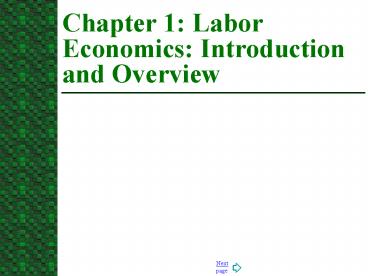Chapter 1: Labor Economics: Introduction and Overview - PowerPoint PPT Presentation
1 / 13
Title:
Chapter 1: Labor Economics: Introduction and Overview
Description:
75% of national income goes to labor. Unique Characteristics. Labor is rented and not bought/sold. Non-monetary aspects. Importance of Labor Economics ... – PowerPoint PPT presentation
Number of Views:286
Avg rating:3.0/5.0
Title: Chapter 1: Labor Economics: Introduction and Overview
1
Chapter 1 Labor Economics Introduction and
Overview
2
- 1. Labor Economics as a Discipline
3
Importance of Labor Economics
- Socioeconomic Issues
- Gender and race discrimination
- Legal and illegal immigration
- Fall in unionization
- Free trade
- Quantitative Importance
- 75 of national income goes to labor.
- Unique Characteristics
- Labor is rented and not bought/sold
- Non-monetary aspects
4
Importance of Labor Economics
- Institutional factors
- Unions, licensing, minimum wage, discrimination
- Labor demand is a derived demand
5
- 2. The Old and the New
6
Change in Labor Economics
- Old Approach
- Highly descriptive and historical.
- Little economic analysis
- New Approach
- Uses applied micro and macro theory
7
- 3. Economic Perspective
8
Choice
- Labor economics uses theories of choice to
explain behavior of labor market participants and
resulting outcomes. - Theories rest on three assumptions
- Relative scarcity
- Purposeful behavior
- Choices involve giving something up -an
opportunity cost - Individuals make choices purposefully with an
expected net gain
9
Choice
- Adaptability
- Workers and firms adapt to changes in expected
costs and benefits
10
- 4. Overview
11
Overview
- Microeconomics
- Individual economic units or markets
- Macroeconomics
- Economy as a whole
12
- Questions for Thought
1. Why must the concepts of supply and demand as
they pertain to products be modified when applied
to labor markets?
2. Indicate whether each of the following
statements pertains to microeconomics or
macroeconomics
(a) The unemployment rate in the United States
was 4.2 percent in 1999.
(b) Bartenders at Andrews Capital Bar and
Grill earn 9.25 per hour.
(c) The productivity of American workers as a
whole has increased by more than 2 percent
per year in the last 4 years.
13
EndChapter 1































